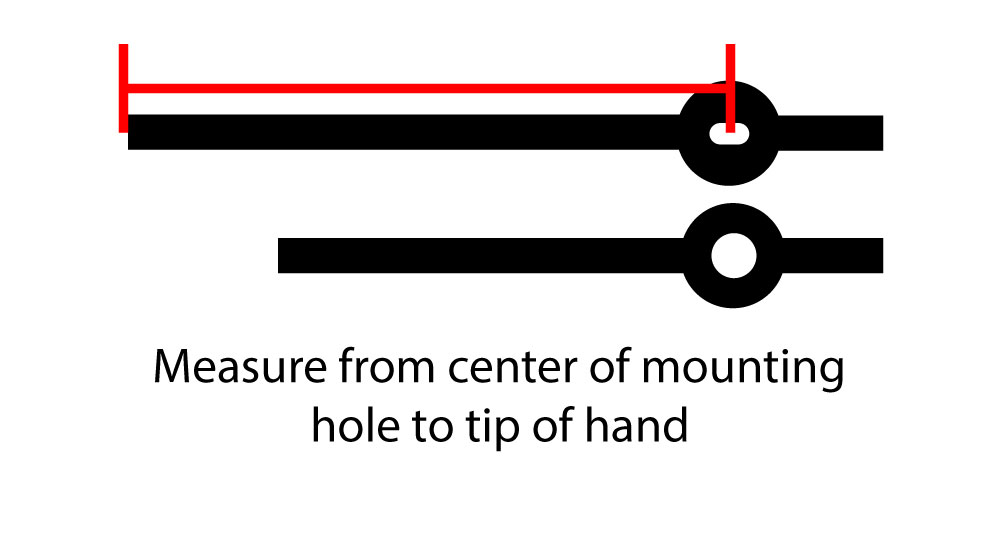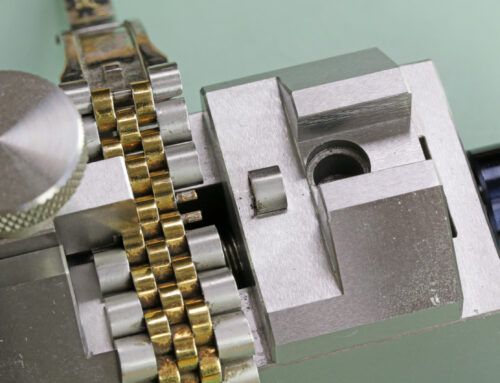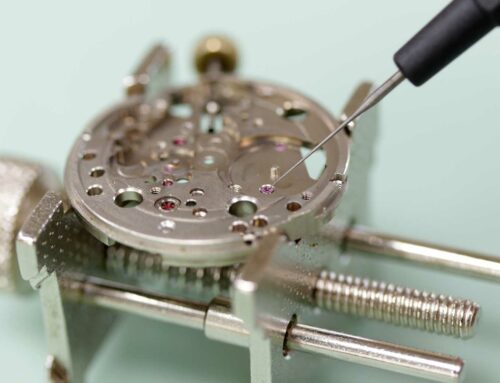Battery operated clock movements come in a variety of options and they all vary a little bit from manufacturer to manufacturer. The holes used to mount the clock are not all the same, so even if you already have clock hands they may not fit onto your new clock movement. Use this guide to help you determine what size clock hands you need for your clock project.
Measure Your Clock
The very first step in determining clock hand size is to measure the diameter of your clock face, also known as a clock dial. Use a ruler to measure the outside diameter of the time ring. If there is no time ring, measure the outside edge of the numbers or markers.
Divide the Diameter by Two
Take the outside diameter measurement and divide it by two to give you the length of the minute hand. The “rules” for clock hand length are pretty relaxed so you can end your minute hand in the middle of the indicator. You can generally be within a 1/4″ and it will still work.
Clock hands are listed with the minute hand length, measured from the middle of the mounting hole to the tip of the hand. The length of the hour hand will correspond with the minute hand so you don’t need to measure the hour hand. Our clock hands are sold by the pair so you will get both minute and hour hands together. If the hands are slightly too long you can always trim the hands to a shorter length; the hands are made of aluminum or brass plated steel so they’re easy to trim.
I-Post vs. Push-On Clock Hands
There are generally two different styles of clock hand mounts: I-post and push-on. With the I-post, the minute hand mounting hole is more rectangular than round to fit onto the post that looks similar in that is is round with two flat sides. The push-on hands style has a smaller round hole on the minute hand than the hour hand to fit over the post on a push-on clock movement. These hands don’t require nuts to hold them in place on the shaft.
Hands Longer Than 4.5″
Clock hands that are larger than 4.5″ need the power of High-Torque Clock Movement to work properly. The length and weight of these hands require a movement with more torque than a standard clock movement to lift the hands around the clock face. High torque clock movements can power hands up to 17-1/2″ long









I enjoy ALL your training information just recently got involved with watch repair –only quartz for now. Thanks for information, find it very informative.
How does one determine the correct hand size for a repair watch that arrived without hands ?
You have to take the diameter of the clock dial or face and divide it by two to get the length of the minute hand depending on where you want to the tip of the hand to end. Hands are sold by the pair so you only really need to know the minute hand length. Some styles of hands are able to be trimmed so if it is too long you can trim it down to the length you need.
If I knew the diameter of the clock face, where does the tip of the hour hand end on the face? I need a set of clock hands for a face 60cm & hour diameter spindle is 5mm.
The hour hand usually ends right before it touches the number for the hour. Here is our listing for oversized clock hands: https://www.esslinger.com/large-oversized-clock-hands/
It looks like you need about a 12″ hand for the minute hand – don’t forget that hands can be trimmed down to fit your clock face.
Hi Folks:
I have been looking for guidance on selecting the right vintage pocket watch hands. especially regarding proper sizing for the depressed second hans. Thanks in advance.
You can use the contact us form for help finding the right hands for your watch. https://www.esslinger.com/contact-us/
Thank you @Esslinger staff, I have resolved the measure of the hands on my Zaanse Klok (Dutch model [sic]). Now it works fine again. Sincerely, FdH
Where can I find 45″ clock hands and a movement?
I appreciate you pointing out that the first step in calculating clock hand size is to measure the diameter of your clock face, also known as a clock dial, so use a ruler to gauge the time ring’s outside diameter. I will share that information with my mother, who has been looking for the ideal clock to go with her rustic-style residence. She should definitely take into account a stamp barrel head clock, though, as such simply look incredible in general.
Esslinger, what size are the holes you need for the push on hands? The hour hand is larger than the minute hand obviously, but what are the exact sizes of the holes for each hand to fit over the mechanism shafts? Thank you!